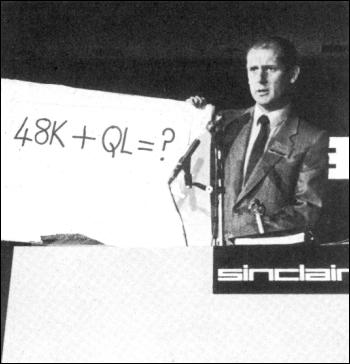| Sinclairvoyance |
A YEAR AGO Sinclairvoyance speculated on Sinclair's expected move into the business market and the continuing success of the Spectrum. Events in 1984 confirmed both, though no-one could have anticipated the eccentric mishandling of the QL and the subsequent caution with which that machine was to be regarded by manufacturers and buyers alike. At the beginning of 1985 it is still uncertain whether the QL will sell in the quantities hoped for by Sinclair Research, and which will justify large investment by software houses. The advent of disk drives, expansion boards and applications software from Quest is just one sign amongst many that the QL is nevertheless ready for lift-off.
What is more uncertain is the future of the Spectrum. Had not the Spectrum+ appeared, things would have looked decidedly dicey for our old friend. With Commodore, Amstrad, MSX and others prepared to slog it out in 1985 it is difficult to see how Sir Clive would have retained his market share.
The Spectrum+ might have changed all that. Internally the same as its little sister, it is an altogether different beast. In discarding those putty rubber keys Sinclair has transformed a games machine into an inexpensive and viable alternative to its rivals. Programming becomes faster and, once you have become accustomed to the all-white key legends, easier. Sensible word-processing is within reach. No more feats of dexterity to sample the dubious delights of inverse video, no more tugging and wiggling at that worn power lead ...
Even more attractive is the inclusion in the price of a slightly different version of the Spectrum Six Pack, intended to always accompany the Spectrum+, something which Sinclair did not make clear when the machine appeared. That software is worth more than £50.00 and consequently, the £179.95 price for the Plus is not as exorbitant as it seems at first glance.

That leaves the old 48K, minus the now-discontinued software promotion, looking rather sorry for itself and it is inevitable that many potential customers will buy the Plus in preference. Sinclair Research hopes of course, that it has not merely split the market share it already has but in addition stolen some from Commodore and chums as well. Any price reduction in the 48K is again likely, to increase that share without reducing sales of the Spectrum+ to any large extent. In other words, Sinclair has covered all the bases and is simply waiting for the away team to pitch. It can't fail to score.
Sinclair has further tricks up its lab coat sleeve. Whispers abound that the Plus might be further upgraded to take onboard the Interface 1 and even a cartridge slot. The basis for that speculation seems to be little more than the fact that the Plus was codenamed Thunderbird, and, as the ageing ones amongst us will know, there were five Thunderbird craft in the TV series. Nigel Searle has kicked that one into touch by explaining that the designer was a Ford Thunderbird fanatic, though he hasn't ruled out the possibility of upgrades.
Sir Clive too has been unusually garrulous on the shape of things to come, waxing lyrical about a portable in the pipeline. The portable micro will be battery-powered and incorporate microdrives. It will also have a flat-screen display but then he said that when the QL was in planning.
The Spectrum Plus Handle, or the QL Minus, will retail at about £300. But don't hold your breath waiting: Sir Clive has said that it will appear in 1985, probably late 1985 well, possibly 1986. Or even ...
Despite all the carping about Sinclair's achievements there is no doubt they are rock-solid in the final analysis. One company to recognise that is ICL, and in announcing its OPD executive toy has signalled a new departure for Sinclair.
The OPD - One Per Desk - is a nifty combination of monitor, keyboard, microdrives and telephone handset which is the ultimate businessman's tool. It offers all the QL software and an amusing built-in speech synthesiser with 200 words for leaving rude messages on your telephone. It can do much more besides, but what interests us is the presence of Sinclair chips, microdrives and Basic in the design. Not only is the OPD an innovative approach to desk-top computers but it is the first time that Sinclair has been heavily involved with the product from another major company.
Lest you feel that in reaching for the business sky, Sinclair Research might have neglected its down-to-earth home users, rest assured: it seems that the Spectrum+ has been bedevilled with the kind of teething problems Sinclair followers have come to expect and fondly treasure.
Some units have 'slipped' through Sinclair's QC net and a few fortunate users have discovered that not only are the keys a great improvement on their plasticene predecessors but are detachable as well. Some machines arrived with assorted keys scattered around the packaging like so many Scrabble tiles.
Middle Eastern carpet weavers used to incorporate deliberate flaws in their designs because only Allah could create anything perfect. Perhaps the distinctive Sinclair bugs and design faults are Sir Clive's errors of humility - his personal, desperate attempt to avoid hubris.
Bill Scolding